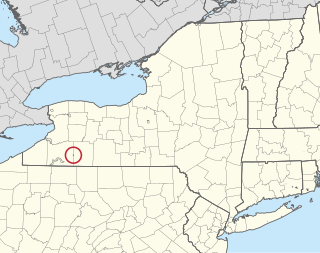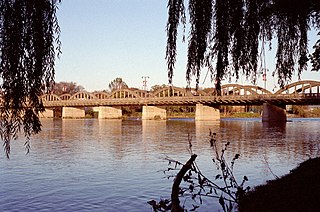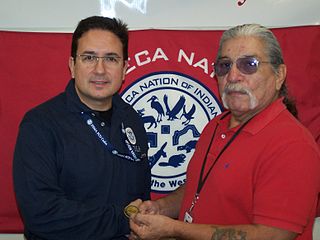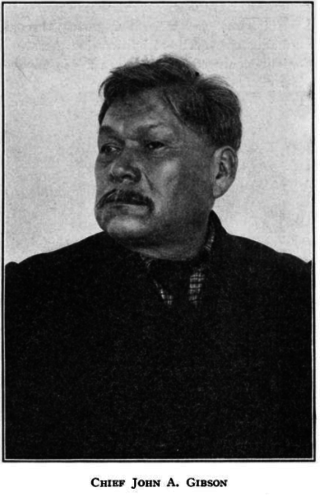
Among the Haudenosaunee the Great Law of Peace, also known as Gayanashagowa, is the oral constitution of the Iroquois Confederacy. The law was written on wampum belts, conceived by Dekanawidah, known as the Great Peacemaker, and his spokesman Hiawatha. The original five member nations ratified this constitution near modern-day Victor, New York, with the sixth nation being added in 1722.

Oil Springs Reservation or Oil Spring Reservation is an Indian reservation of the federally recognized Seneca Nation that is located in southwestern New York, United States. As of the 2010 census, the Indian reservation had one resident; in 2005 no tribal members had lived on the property. The reservation covers about one square mile (2.6 km2), divided between the present-day counties of Allegany and Cattaraugus. The reservation is northwest of the village of Cuba. It is bordered by the Town of Cuba and the Town of Ischua.

Caledonia is a community located on the Grand River in Haldimand County, Ontario, Canada. It had a population of 12,179 as of the 2021 Canadian Census. Caledonia is within Ward 3 of Haldimand County. The Councillor elected for Ward 3 is Dan Lawrence. As of 2021, there were 4,310 private dwellings in Caledonia.

Haldimand County is a rural city-status single-tier municipality on the Niagara Peninsula in Southern Ontario, Canada, on the north shore of Lake Erie, and on the Grand River. Despite its name, it is no longer a county by definition, as all municipal services are handled by a single level of government. Municipal offices are located in Cayuga.
The Seneca are a group of Indigenous Iroquoian-speaking people who historically lived south of Lake Ontario, one of the five Great Lakes in North America. Their nation was the farthest to the west within the Six Nations or Iroquois League (Haudenosaunee) in New York before the American Revolution. For this reason, they are called “The Keepers of the Western Door.”

The Phelps and Gorham Purchase was the sale, in 1788, of a portion of a large tract of land in western New York State owned by the Seneca nation of the Iroquois Confederacy to a syndicate of land developers led by Oliver Phelps and Nathaniel Gorham. The larger tract of land is generally known as the "Genesee tract" and roughly encompasses all that portion of New York State west of Seneca Lake, consisting of about 6,000,000 acres (24,000 km2).

The Grand River, formerly known as the River Ouse, is a large river in Ontario, Canada. It lies along the western fringe of the Greater Golden Horseshoe region of Ontario which overlaps the eastern portion of southwestern Ontario, sometimes referred to as Midwestern Ontario, along the length of this river. From its source near Wareham, Ontario, it flows south through Grand Valley, Fergus, Elora, Waterloo, Kitchener, Cambridge, Paris, Brantford, Ohsweken, Six Nations of the Grand River, Caledonia, and Cayuga before emptying into the north shore of Lake Erie south of Dunnville at Port Maitland. One of the scenic and spectacular features of the river is the falls and Gorge at Elora.

The Onondaga people are one of the five original nations of the Haudenosaunee (Iroquois) Confederacy in the Northeastern Woodlands. Their historical homelands are in and around present-day Onondaga County, New York, south of Lake Ontario.

Six Nations is demographically the largest First Nations reserve in Canada. As of the end of 2017, it has a total of 27,276 members, 12,848 of whom live on the reserve. These nations are the Mohawk, Cayuga, Onondaga, Oneida, Seneca and Tuscarora. Some Lenape live in the territory as well.

The Cayuga are one of the five original constituents of the Haudenosaunee (Iroquois), a confederacy of Native Americans in New York. The Cayuga homeland lies in the Finger Lakes region along Cayuga Lake, between their league neighbors, the Onondaga to the east and the Seneca to the west. Today, Cayuga people belong to the Six Nations of the Grand River First Nation in Ontario, and the federally recognized Cayuga Nation of New York and the Seneca-Cayuga Tribe of Oklahoma.
Six Nations may refer to:
First Nations in Ontario constitute many nations. Common First Nations ethnicities in the province include the Anishinaabe, Haudenosaunee, and the Cree. In southern portions of this province, there are reserves of the Mohawk, Cayuga, Onondaga, Oneida, Seneca and Tuscarora.
The Tonawanda Seneca Nation is a federally recognized tribe in the State of New York. They have maintained the traditional form of government led by sachems selected by clan mothers. The Seneca are one of the original Five Nations of the Haudenosaunee or Iroquois Confederacy. Their people speak the Seneca language, an Iroquoian language.

John Norton (Teyoninhokarawen) was a Mohawk chief, Indian Department interpreter and a school master. He was adopted by the Mohawk at about age 30 at their major reserve in Canada. After deserting the British military in the late 18th century, he became a military leader of Iroquois warriors in the War of 1812 on behalf of Great Britain against the United States. Commissioned as a major, he led warriors from the Six Nations of the Grand River into battle against American invaders at Queenston Heights, Stoney Creek, and Chippawa.

The Iroquois, also known as the Five Nations, and later as the Six Nations from 1722 onwards; alternatively referred to by the endonym Haudenosaunee are an Iroquoian-speaking confederacy of Native Americans and First Nations peoples in northeast North America. They were known by the French during the colonial years as the Iroquois League, and later as the Iroquois Confederacy, while the English simply called them the "Five Nations". The peoples of the Iroquois included the Mohawk, Oneida, Onondaga, Cayuga, and Seneca. After 1722, the Iroquoian-speaking Tuscarora people from the southeast were accepted into the confederacy, from which point it was known as the "Six Nations".

The Seneca Nation of Indians is a federally recognized Seneca tribe based in western New York. They are one of three federally recognized Seneca entities in the United States, the others being the Tonawanda Band of Seneca and the Seneca-Cayuga Nation of Oklahoma. Some Seneca also live with other Iroquois peoples on the Six Nations of the Grand River in Ontario.

Six Nations Polytechnic (SNP) is a Haudenosaunee-governed Indigenous institute on Six Nations of the Grand River First Nation. SNP is an Indigenous Institute, the third pillar of post-secondary education in Ontario, as recognized by the Indigenous Institutes Act of 2017, The Six Nations of the Grand River First Nation are the Mohawk, Cayuga, Onondaga, Oneida, Seneca, and Tuscarora. The Six Nations of the Grand River First Nation reserve acreage at present covers some 46,000 acres (190 km2) near the city of Brantford, Ontario. Six Nations Polytechnic has two campuses, one located in Ohsweken and one located in Brantford.
The Niharondasa Seneca First Nation is a Seneca First Nation in southern Ontario, and a member nation of the Six Nations of the Grand River. Its reserves include the shared reserves of Glebe Farm 40B and the Six Nations of the Grand River First Nation.

John Arthur Gibson (1850–1912) was a chief of the Seneca nation of the North American Iroquois confederation. Part Onondaga and part Seneca, he resided within the reserve of the Six Nations of the Grand River in Ontario, Canada. Knowledgeable about Iroquois (Haudosaunee) culture, he is best known for the versions he provided of the Iroquois oral constitution, the Great Law of Peace. He acted as an advisor to the Canadian Department of Indian Affairs in matters relating both to Iroquois and non-Iroquois indigenous people. He was a well-respected player of the traditional Iroquois sport of lacrosse until he was blinded during a game when he was 31.
Simeon Gibson was a member of the Cayuga tribe and the Onondaga Longhouse on the Six Nations Reserve. Gibson (Iroquois) worked closely with Iroquois researchers, including Horatio Hale, David Boyle, Mark Raymond Harrington, A.C. Parker, and John Napoleon Brinton (J.N.B.) Hewitt. Gibson worked with these researchers to interpret his father Chief Gibson’s two records of the Daganawi:dah legend.












